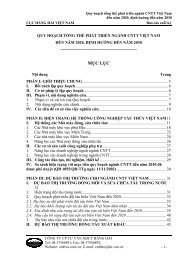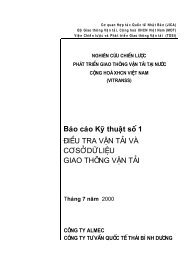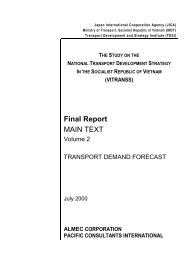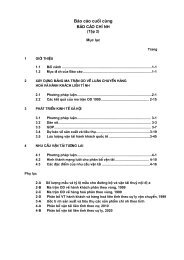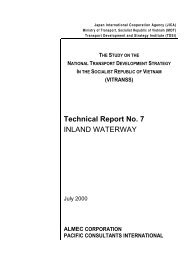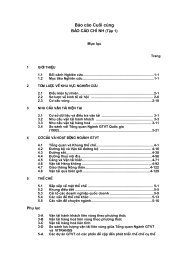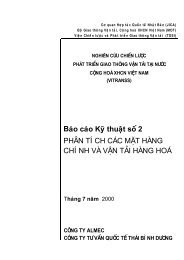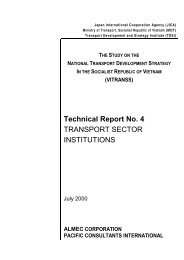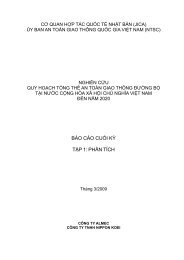Technical Report No. 8 PORT AND SHIPPING
Technical Report No. 8 PORT AND SHIPPING
Technical Report No. 8 PORT AND SHIPPING
You also want an ePaper? Increase the reach of your titles
YUMPU automatically turns print PDFs into web optimized ePapers that Google loves.
I-4-2<br />
Vietnam National Transport Strategy Study (VITRANSS)<br />
<strong>Technical</strong> <strong>Report</strong> <strong>No</strong>. 8<br />
Shipping and Ports<br />
transported by national ships and declare this as expenditures which can be<br />
deducted from their fiscal income (Income Tax Rules 1995).<br />
4) Ship depreciation: In Indonesia, the following ship depreciation rule under the<br />
1994 income tax law is applied:<br />
Ship Tonnage (DWT) Class Depreciation %<br />
Less than 100<br />
1<br />
4 years<br />
50<br />
Up to 100<br />
2<br />
8 years<br />
25<br />
100-1,000<br />
3<br />
16 years<br />
12.5<br />
Over 1,000<br />
4<br />
20 years<br />
10<br />
The depreciation term on second-hand vessels is applied using the original<br />
owner’s selected term.<br />
In Malaysia, there are provisions for vessel depreciation and accelerated<br />
depreciation is allowed. Details will be mentioned in the ESCAP report.<br />
In Taiwan, there is no specific policy supporting its shipping industry except<br />
for an exemption from corporate tax. Perhaps, it prefers to follow APEC<br />
maritime initiatives and the Asian shipping forum, supporting a freer and<br />
more fair competition in the shipping industry.<br />
4.1.2 Fiscal Measures in Malaysia<br />
1) Bank Industri: Bank Industri is the first bank in Malaysia to go into the<br />
shipping industry. Until now, their main business is still the financing of ships,<br />
shipyards and marine-related activities. Government, through the Five-year<br />
Malaysian Plan, allocates funds to Bank Industri. Those wanting to apply for<br />
loans for shipbuilding should purchase the vessel from the local shipyard. If<br />
local yards were incapable of building the required vessel, then foreign<br />
purchase would be allowed.<br />
2) Shipping Fund: The Shipping Fund established by government is intended for<br />
eligible local shipping companies who wish to expand and increase their<br />
carrying capacity to meet the growth of export following the rapid pace of<br />
industrialization (Prime Minister’s Speech, 1995).<br />
The two main components of this fund are the Ship Finance Facility (SFF)<br />
and the Shipping Venture Facility (SVF). Initially, when this fund was<br />
established, government, through Bank Nagra, provided a sum of RM 800<br />
million. Bank Nagra then chose Bank Industri as the managing authority of<br />
this fund. Of the government allocation, RM 300 million was set aside for the<br />
acquisition of new and second-hand vessels under the SFF program. The RM<br />
500 million balance was intended for the SVF program (EPU: 1993). Under



